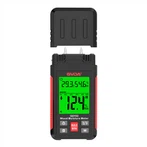The basic principles of rangefinders can be divided into three categories:
1. Laser rangefinder
Laser rangefinder is an instrument that accurately measures the distance of a target using lasers. The laser rangefinder emits a very fine laser beam towards the target during operation, and the photoelectric element receives the reflected laser beam from the target. The timer measures the time from emission to reception of the laser beam and calculates the distance from the observer to the target.
Laser rangefinders are currently the most widely used rangefinders, which can be classified into handheld laser rangefinders (measuring distances of 0-300 meters) and telescope laser rangefinders (measuring distances of 500-3000 meters).
2. Ultrasonic rangefinder
Ultrasonic rangefinders measure the characteristics of ultrasonic waves reflected back from obstacles. The ultrasonic transmitter emits ultrasonic waves in a certain direction and starts timing at the same time. The ultrasonic waves propagate in the air and immediately return when encountering obstacles. The ultrasonic receiver immediately interrupts and stops timing when receiving reflected waves. By continuously detecting the echo reflected by obstacles after wave emission, the time difference T between the emission of ultrasonic waves and the reception of echoes is measured, and then the distance L is calculated.
Ultrasonic rangefinders, due to the significant impact of the surrounding environment on ultrasound, generally have shorter measurement distances and lower measurement accuracy. At present, the scope of use is not very broad, but the price is relatively low, usually around a few hundred yuan.
3. Infrared rangefinder
An instrument that uses modulated infrared light for precise ranging, with a measuring range generally of 1-5 kilometers. The principle of non diffusion during infrared propagation is utilized: because infrared rays have a low refractive index when passing through other substances, long-distance rangefinders will consider infrared rays, and the propagation of infrared rays takes time. When infrared rays are emitted from the rangefinder, they are reflected back and received by the rangefinder, and then the distance can be calculated based on the time from the emission to reception of infrared rays and the propagation speed of infrared rays
The advantages of infrared rangefinders are cheap, easy to manufacture, and convenient, while the disadvantages are low accuracy, close range, and poor directionality.






